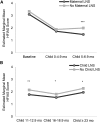Maternal and Child Supplementation with Lipid-Based Nutrient Supplements, but Not Child Supplementation Alone, Decreases Self-Reported Household Food Insecurity in Some Settings
- PMID: 28978680
- PMCID: PMC5697970
- DOI: 10.3945/jn.117.257386
Maternal and Child Supplementation with Lipid-Based Nutrient Supplements, but Not Child Supplementation Alone, Decreases Self-Reported Household Food Insecurity in Some Settings
Abstract
Background: It is unknown whether self-reported measures of household food insecurity change in response to food-based nutrient supplementation.Objective: We assessed the impacts of providing lipid-based nutrient supplements (LNSs) to women during pregnancy and postpartum and/or to their children on self-reported household food insecurity in Malawi [DOSE and DYAD trial in Malawi (DYAD-M)], Ghana [DYAD trial in Ghana (DYAD-G)], and Bangladesh [Rang-Din Nutrition Study (RDNS) trial].Methods: Longitudinal household food-insecurity data were collected during 3 individually randomized trials and 1 cluster-randomized trial testing the efficacy or effectiveness of LNSs (generally 118 kcal/d). Seasonally adjusted Household Food Insecurity Access Scale (HFIAS) scores were constructed for 1127 DOSE households, 732 DYAD-M households, 1109 DYAD-G households, and 3671 RDNS households. The impact of providing LNSs to women during pregnancy and the first 6 mo postpartum and/or to their children from 6 to 18-24 mo on seasonally adjusted HFIAS scores was assessed by using negative binomial models (DOSE, DYAD-M, and DYAD-G trials) and mixed-effect negative binomial models (RDNS trial).Results: In the DOSE and DYAD-G trials, seasonally adjusted HFIAS scores were not different between the LNS and non-LNS groups. In the DYAD-M trial, the average household food-insecurity scores were 14% lower (P = 0.01) in LNS households than in non-LNS households. In the RDNS trial, compared with non-LNS households, food-insecurity scores were 17% lower (P = 0.02) during pregnancy and the first 6 mo postpartum and 15% lower (P = 0.02) at 6-24 mo postpartum in LNS households.Conclusions: The daily provision of LNSs to mothers and their children throughout much of the "first 1000 d" may improve household food security in some settings, which could be viewed as an additional benefit that may accrue in households should policy makers choose to invest in LNSs to promote child growth and development. These trials were registered at clinicaltrials.gov as NCT00945698 (DOSE) NCT01239693 (DYAD-M), NCT00970866 (DYAD-G) and NCT01715038 (RDNS).
Keywords: Bangladesh; Ghana; Malawi; food insecurity; lipid-based nutrient supplements.
Conflict of interest statement
Author disclosures: KPA, EA, TEP, MKM, SA-A, MA, CDA, JC, SH, CK, SLM, UA, AL, KMM, SAV, and KGD, no conflicts of interest.
Figures







References
-
- FAO. Rome Declaration on World Food Security and World Food Summit Plan of Action [Internet].c1996 [cited 2017 Apr 17]. Available from: http://www.fao.org/docrep/003/w3613e/w3613e00.htm.
-
- Maxwell D, Coates J, Vaitla B. How do different indicators of household food security compare? Empirical evidence from Tigray [Internet]. c2013 [cited 2017 Apr 17]. Available from: http://fic.tufts.edu/assets/Different-Indicators-of-HFS.pdf.
-
- Webb P, Coates J, Frongillo EA, Rogers BL, Swindale A, Bilinsky P. Measuring household food insecurity: why it’s so important and yet so difficult to do. J Nutr 2006;136:1404S–8S. - PubMed
-
- Barrett CB. Measuring food insecurity. Science 2010;327:825–8. - PubMed
Publication types
MeSH terms
Substances
Associated data
LinkOut - more resources
Full Text Sources
Other Literature Sources
Medical

